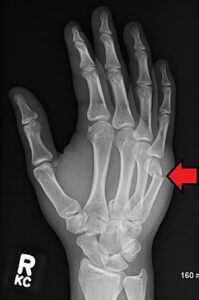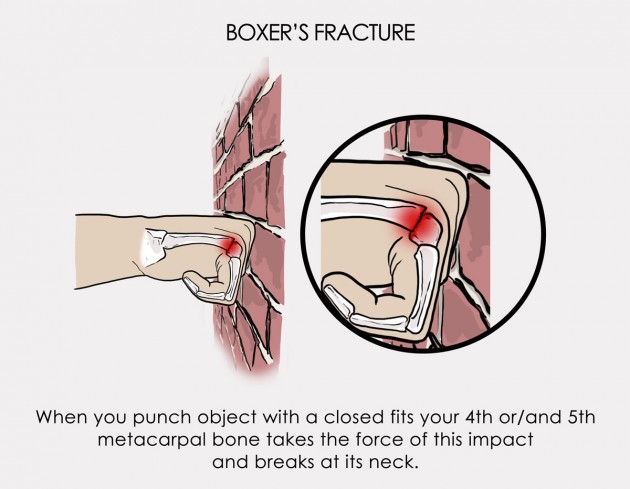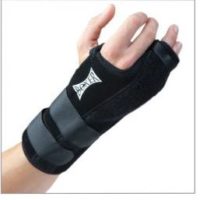Boxer’s fracture
Last Updated on August 12, 2024 by The SportsMD Editors
A boxer’s fracture is a fracture, or break, of the fifth metacarpal bone of the hand, at the metacarpal neck. This is the bone associated with the small finger. When fractured, usually after punching an object like a boxer, it is often angulated and/or displaced requiring reduction and or surgical fixation.
Click the following link to learn about a metacarpal fracture.
Anatomy related to a boxer’s fracture
 The hand is made up of five metacarpal bones, numbered one to five from the thumb side to the small finger side of the hand, and fourteen phalanges or finger bones. The fifth metacarpal gives structure to the medial boarder of the hand and can be felt below the skin. The lumbrical and interosseous muscles, attached to the fifth metacarpal, cause the fracture to angulate apex dorsal, towards the back of the hand.
The hand is made up of five metacarpal bones, numbered one to five from the thumb side to the small finger side of the hand, and fourteen phalanges or finger bones. The fifth metacarpal gives structure to the medial boarder of the hand and can be felt below the skin. The lumbrical and interosseous muscles, attached to the fifth metacarpal, cause the fracture to angulate apex dorsal, towards the back of the hand.
Causes of boxer’s fracture
 A boxer’s fracture is usually the result of punching a hard object with an unprotected fist. The fifth metacarpal bone is loaded along its longitudinal axis through the metacarpal head at the metacarpophalangeal joint, or knuckle, and fractures in the shaft of the bone. A combination of this axial load and the deforming forces of the lumbrical and interosseous muscles cause an apex dorsal angulation.
A boxer’s fracture is usually the result of punching a hard object with an unprotected fist. The fifth metacarpal bone is loaded along its longitudinal axis through the metacarpal head at the metacarpophalangeal joint, or knuckle, and fractures in the shaft of the bone. A combination of this axial load and the deforming forces of the lumbrical and interosseous muscles cause an apex dorsal angulation.
How does one examine a boxer’s fracture?
Physical examination of a boxer’s fracture focuses on determining the orientation of the fracture and its effect on the rotation of the small finger. The examination needs to make sure that there is no overlap of the small finger on the ring finger or significant divergence from the ring finger when compared to the other side. A complete neurovascular examination of the hand and small finger is performed to make sure that the nerves and vessels to the finger are uninjured. Radiographs, or x-rays, of the hand in multiple planes are used to determine the fracture orientation, including angulation and displacement.
When to See the Doctor
Hundreds of athletes sustain acute injuries every day, which can be treated safely at home using the P.R.I.C.E. principle. But if there are signs or symptoms of a serious injury, emergency first aid should be provided while keeping the athlete calm and still until emergency service personnel arrive. Signs of an emergency situation when you should seek care and doctor treatment can include:
- Bone or joint that is clearly deformed or broken
- Severe swelling and/or pain,
- Unsteady breathing or pulse
- Disorientation or confusion
- Paralysis, tingling, or numbness
In addition, an athlete should seek medical care if acute symptoms do not go away after rest and home treatment using the P.R.I.C.E principle.
Potential complications of a boxer’s fracture
Over angulation of a boxer’s fracture can lead to a prominent metacarpal head felt in the palm of the hand, and cause decreased grip strength. Further, a rotationally malaligned metacarpal can cause a grasp abnormality. Splinting or casting of the hand in a position other than intrinsic plus position can lead to an extension contracture at the MCP joint and dysfunction of the hand.
Boxer’s fracture splint
 Conservative treatment of a boxer’s fracture is warranted in most situations where there is not significant fracture angulation and there is no significant rotational deformity. Conservative care involves possible fracture reduction, often requiring local anesthetic, followed by boxer’s fracture splint or casting of the hand and small finger in the intrinsic plus position (MCP flexion, PIP and DIP extension). Allowing for some digital motion may produce improved results.
Conservative treatment of a boxer’s fracture is warranted in most situations where there is not significant fracture angulation and there is no significant rotational deformity. Conservative care involves possible fracture reduction, often requiring local anesthetic, followed by boxer’s fracture splint or casting of the hand and small finger in the intrinsic plus position (MCP flexion, PIP and DIP extension). Allowing for some digital motion may produce improved results.
Acceptable angulation is less than thirty degrees, with decreasing grip strength associated with increased angulation. The period of immobilization should last three to four weeks, followed by protective splinting until six weeks, with fracture healing requiring six to ten weeks.
More Information: Read about sports injury treatment using the P.R.I.C.E. principle – Protection, Rest, Icing, Compression, Elevation.
Boxers Fracture Surgery
Boxers Fracture Surgery is indicated for those fractures with unacceptable angulation or rotation, or a reduction that is not stable in a splint or cast. Surgical fixation methods range from transmetacarpal or interosseous pinning to plate and screw fixation. High level athletes may opt for internal fixation to allow for the potential of earlier return to play. K-wire fixation is often used for better cosmetic results. Surgical fixation adds the usual surgical risks of infection, neurologic injury, and bleeding, as well as the risks of hardware failure and extensor mechanism injury.
What is the prognosis for an athlete suffering a boxer’s fracture?
The long term prognosis of a boxer’s fracture is good. Although highly angulated fractures tend to heal, one may have decreased grip strength, which is rarely clinically significant. In the athlete however, one may be more aggressive with fixation. Internal fixation allows for return to play in a protective cast or splint within two weeks of surgery. One must remain protected however until full osseous union at 6-10 weeks. The athlete’s age, level, sport, position and time of season must all be taken into account when deciding on a treatment plan.
Get a Virtual Sports Specialized appointment within 5 minutes for $29
 When you have questions like: I have an injury and how should I manage it? How severe is it and should I get medical care from an urgent care center or hospital? Who can I talk to right now? SportsMD Virtual Urgent Care is available by phone or video anytime, anywhere 24/7/365, and appointments are within 5 minutes. Learn more via SportsMD’s Virtual Urgent Care Service.
When you have questions like: I have an injury and how should I manage it? How severe is it and should I get medical care from an urgent care center or hospital? Who can I talk to right now? SportsMD Virtual Urgent Care is available by phone or video anytime, anywhere 24/7/365, and appointments are within 5 minutes. Learn more via SportsMD’s Virtual Urgent Care Service.
Boxer’s Fracture Exercises
Questions and Answeres:
When discussing a boxer’s fracture or any medical condition with a doctor, asking questions can help you better understand your situation and treatment options. Here are some questions you can ask, along with potential answers from a healthcare professional:
- What is a boxer’s fracture?
- A boxer’s fracture is a type of fracture in the hand, typically involving the metacarpal bone of the little finger (pinky finger).
- How did I get this fracture, and what are the common causes?
- Boxer’s fractures often result from direct trauma to the hand, such as a punch or striking a hard object.
- What are my treatment options?
- Treatment options may include casting, splinting, or, in some cases, surgical intervention, depending on the severity of the fracture.
- Do I need surgery for this fracture, or can it be treated conservatively?
- The need for surgery depends on the extent of the fracture and the alignment of the bones. Your doctor will advise you on the best approach.
- How long will my recovery take?
- Recovery time varies depending on the treatment method and the severity of the fracture. Your doctor can provide an estimate based on your specific case.
- What kind of rehabilitation or physical therapy will I need?
- Depending on the treatment, you may require hand therapy to regain strength and mobility.
Your doctor will provide personalized answers to these questions, so feel free to ask additional questions or seek clarification on any points you don’t fully understand. Effective communication with your healthcare provider is essential for your treatment and recovery.
References
- DeLee, Jesse, David Drez, and Mark D. Miller. Delee & Drez’s Orthopaedic Sports Medicine : Principles and Practice. 3rd ed. Philadelphia: Saunders/Elsevier, 2010. Print.
- Henry, M. H. “Fractures of the Proximal Phalanx and Metacarpals in the Hand: Preferred Methods of Stabilization.” J Am Acad Orthop Surg 16 10 (2008): 586-95. Print.
- Morgan, W. J., and L. S. Slowman. “Acute Hand and Wrist Injuries in Athletes: Evaluation and Management.” J Am Acad Orthop Surg 9 6 (2001): 389-400. Print.

